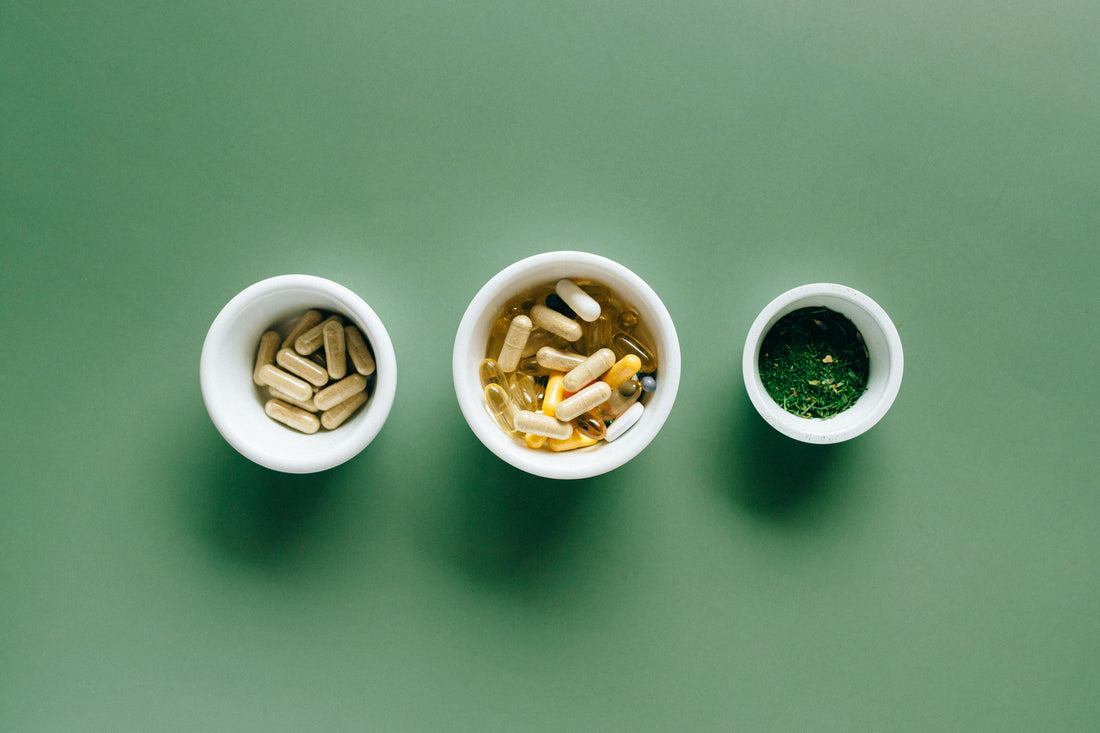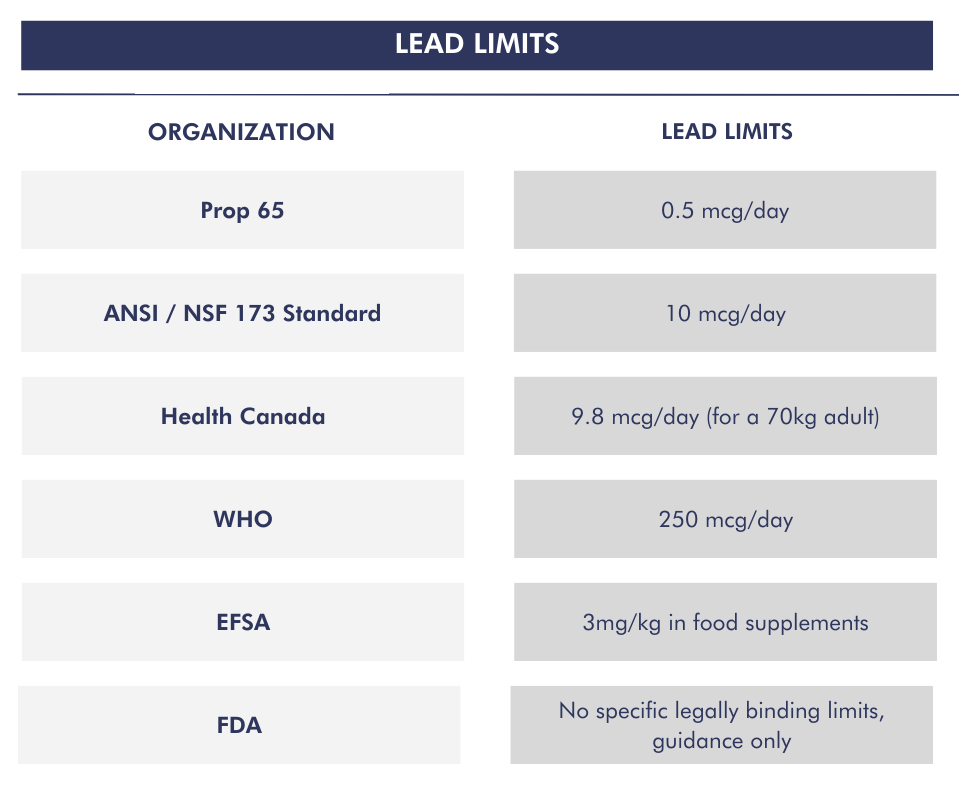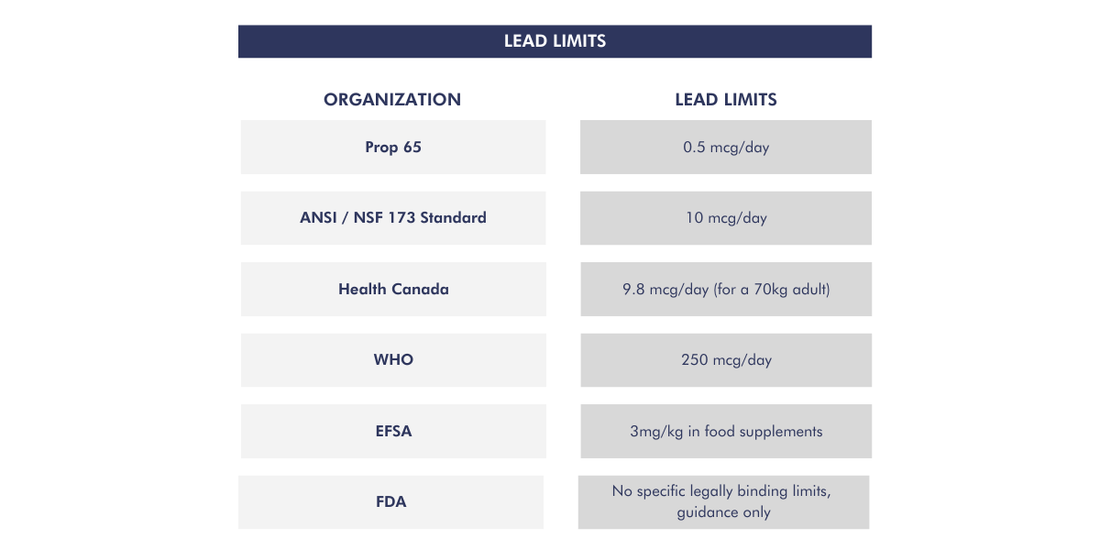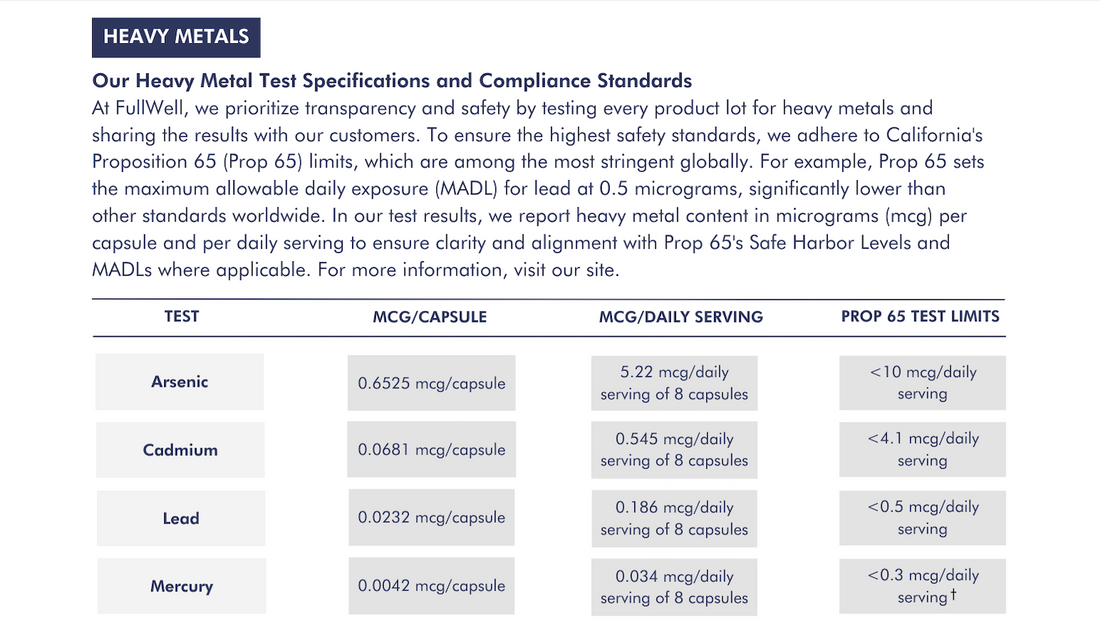Understanding Heavy Metals in Food and Supplements
TL;DR
- Heavy metals are natural but increasingly prevalent due to industrial and agricultural activities, posing potential health risks.
- Exposure occurs through food, water, air, and consumer products, and excessive levels can overwhelm the body's detoxification system.
- Reducing exposure includes rinsing and soaking food, filtering water, and choosing rigorously tested products.
- Regulations vary globally, with the FDA setting U.S. guidelines and California Proposition 65 enforcing the strictest limits.
- FullWell upholds the highest safety standards through multi-stage heavy metal testing and a commitment to transparency.

What Are Heavy Metals?
Heavy metals are naturally occurring elements found in the Earth’s crust, soil, and water. Common examples include mercury, arsenic, cadmium, and lead. While trace amounts are unavoidable and typically harmless, modern industrial activities—like mining, traffic emissions, and agricultural runoff—have significantly increased their prevalence in our environment. These metals can infiltrate the food chain, accumulating in plants, animals, and, eventually, humans.
In high concentrations, heavy metals pose serious health risks, particularly to vulnerable populations like children and pregnant women. For example, lead exposure can impact brain development in children, while mercury can harm the nervous system. At FullWell, we prioritize rigorous testing of our products, ensuring they meet strict safety standards to minimize exposure. As a reproductive health company that makes products for women and their partners, including those who are trying to get pregnant, pregnant, postpartum and breastfeeding, we take an extremely conservative approach to safety by adopting and adhering to the most conservative standards that exist solely to protect the health and well-being of you, the consumer. We will never release a product that doesn’t pass our strict specifications and quality control process. This ensures the highest level of safety and trust for our customers.
How Do Heavy Metals Enter Our Bodies?
Natural and Human Sources
Heavy metals can enter the body in multiple ways:
- Food and Water: When it comes to food and water, some crops and seafood are more vulnerable to contamination than others. For instance, rice absorbs arsenic from the soil more easily than wheat, and larger, long-lived fish often accumulate higher levels of heavy metals. This doesn’t mean we need to avoid these nutritious foods entirely; rather, it emphasizes the importance of strict monitoring and regulation in industrial and agricultural practices. In the sections that follow, you’ll find practical tips for minimizing risks associated with foods naturally higher in heavy metals.
A note on minerals and why they shouldn’t be avoided:
Despite these trace contaminants, minerals remain essential to a healthy diet. They are critical for numerous bodily functions, including bone health, oxygen transport, and enzyme activity. The body requires a delicate balance of minerals, and deficiencies can lead to significant health problems. For instance, iron is vital for producing hemoglobin in red blood cells, while calcium supports strong bones and proper nerve function. High-quality, tested dietary supplements can provide these benefits while minimizing potential heavy metal exposure. In other words, while trace amounts cannot be avoided entirely, proper testing ensures the levels remain 1000 times lower than levels known to cause harm. - Airborne Particles: Industrial emissions, fossil fuel combustion, and traffic pollution contribute to heavy metal exposure via inhalation.
- Consumer Products: Items like paints, cosmetics, personal care products, cookware, and even some dietary supplements may contain excessively high amounts of heavy metals due to insufficient regulation and testing.
Human Negligence
Human activities, such as improper disposal of industrial waste, overuse of fertilizers, and lack of stringent testing in manufacturing, exacerbate heavy metal contamination. For example, agricultural runoff containing fertilizers with cadmium or lead can contaminate water supplies. These factors highlight the importance of choosing products from transparent and responsible companies that take extra steps to ensure safety. At FullWell, we have an internal auditing process for all incoming raw materials to ensure the quality of the ingredients and adherence to safety standards related to all things, including heavy metals. This is all validated by a strict testing standard that FullWell adopts for all our products. While we are doing the right thing, this points to the need for federal (and global) regulation because these human activities create an environment where it is arguably impossible to meet your nutrition needs without some exposure to heavy metals.
Additional Pathways
Heavy metals are also introduced into the food chain through industrial practices such as mining and smelting. This is particularly concerning for seafood, as fish and shellfish can accumulate mercury and arsenic from polluted waters. Another overlooked source is household dust, which may contain lead particles from older paint or contaminated soil. Checking your home for lead paint is one of the most important safety steps you can take that is within your control.
Detoxification and the Human Body
The good news is that the human body has detoxification mechanisms, primarily through the liver and kidneys. These organs filter toxins and heavy metals, converting them into compounds that can be excreted. However, these systems have limits:
- Low-Level Exposure: The body can usually manage minimal exposure without significant harm.
- Heavy Exposure: Prolonged or excessive exposure can overwhelm detox pathways, leading to bioaccumulation in tissues and organs. This can result in chronic health conditions, such as kidney damage, neurological disorders, or developmental delays in children.
Balancing the risks
While it’s true that no level of heavy metal exposure is entirely safe, it’s also unavoidable due to the ubiquity of these elements in the environment. A close comparison is what we now see with microplastics. Microplastics and their associated contaminants have been found in human organs—an alarming yet inescapable reality. Instead of fixating on complete avoidance, the focus should be on minimizing exposure and enhancing/supporting detoxification processes. This is the most important thing you can do within your control.
Practical Strategies to Reduce Heavy Metals
- Rinse Foods: Soaking and rinsing foods like rice can significantly reduce arsenic content.
- Filter water: High-quality water filters can also minimize lead and cadmium levels in drinking water.
- **Choose Thoroughly Tested Products from Transparent Brands**: Look for brands that conduct third-party testing through ISO-certified labs, ensuring their products meet strict standards for heavy metal limits. ISO certified means that an organization has met the requirements of an ISO standard, which is a globally recognized benchmark for quality, safety, and sustainability. Also, look for published data from these third-party tests and results from individual product batches/lots, instead of relying on third-party certifications that have more lax testing standards, influencers, or watchdog groups.
- Nutrient Support: Include foods rich in natural chelating agents, such as cilantro, garlic, and chlorella. Note that while leafy greens may contain heavy metals from the soil, they are also rich in chlorophyll, which naturally helps bind heavy metals so that your body can remove them efficiently. This is nature working at its best! Additionally, nutrients like selenium, zinc, and vitamin C can support the body’s detoxification processes. Again, while heavy metals like mercury are found in fish, you'll also find relatively high levels of selenium coexisting in these foods. A balanced diet with these foods can enhance resistance to heavy metal accumulation.
- Reduce Exposure at Home: Avoid using products with known contaminants, such as old lead-based paint or low-quality cookware.
Understanding The Regulatory Landscape
U.S. Standards
The U.S. Food and Drug Administration (FDA) provides guidance* on safe levels of heavy metals.
- Interim Reference Levels (IRLs): Updated in 2022, these levels recommend 2.2 μg/day of lead for children and 8.8 μg/day for women of childbearing age (WOCBA). These levels are designed to protect vulnerable populations, such as pregnant women, from harmful exposure.
- Closer to Zero Initiative: This program aims to reduce heavy metal exposure in baby food, with a particular emphasis on lead, arsenic, cadmium, and mercury. The goal is to reduce dietary exposure to these naturally occurring contaminants to as low as possible while maintaining access to nutritious foods.
*The U.S. Food and Drug Administration (FDA) provides guidance on safe levels of heavy metals, intended as a framework rather than a strict mandate.
Global Standards
Regulations vary by region. For instance:
- Health Canada sets more conservative limits for heavy metals in supplements and baby food than the U.S., reflecting stricter safety thresholds.
- European Union: Maintains some of the most stringent regulations worldwide for food and supplement contaminants. The EU frequently updates its guidelines to reflect the latest scientific research.
Here is a look at how lead, specifically, is handled by different organizations:
California Proposition 65
California Proposition 65 (Prop 65) establishes limits on chemical exposure that are far stricter than federal and even all other global guidelines, applying safety factors 1,000 times lower than the level at which no adverse effects have been observed. Products exceeding these thresholds are required to include warning labels, though they are not prohibited from sale. While the intention behind Prop 65 is to enhance consumer protection, its stringent standards can create confusion when they diverge from federal guidelines set by agencies like the FDA and EPA. This discrepancy has been noted to potentially cause unnecessary alarm among consumers. However, to be ultra-conservative, FullWell is committed to ensuring our products are lower than Prop 65 limits for heavy metals.
Organizations like the Council for Responsible Nutrition (CRN) advocate for unified, science-based federal standards that protect public health while maintaining practicality and consistency across all states. Federal agencies already oversee food and dietary supplement manufacturing, including stringent protocols for testing and monitoring heavy metal content. Aligning state and federal guidelines could improve clarity and reduce the risk of misinterpretation for consumers.
Prop 65, enacted in 1986, requires businesses to disclose the presence of chemicals known to cause cancer or reproductive harm. It sets stringent limits for heavy metals:
- Lead: Maximum allowable dose level (MADL) is 0.5 μg/day.
- Cadmium: MADL is 4.1 μg/day.
- Mercury: Although not officially listed, settlements have established exposure levels of 0.3 μg/day for organic mercury and 3.0 μg/day for inorganic mercury.
- Arsenic: The maximum Allowable Dose Level (MADL) for arsenic is not listed; however, the No Significant Risk Level (NSRL) is 10 μg/day.
Proposition 65 provides a model for stricter regulation but also highlights the challenges of achieving ultra-low limits in natural products, especially those derived from plants and marine sources.
The Reality of Heavy Metals in Natural vs. Manufactured Products
Heavy metals are naturally occurring elements found in soil and water, which means they are not exclusive to manufactured products—even natural products can contain trace amounts. This is normal and can happen via several ways as previously discussed.
While heavy metals in both natural and manufactured products are a concern, responsible agricultural and manufacturing practices can significantly reduce these risks. This gives brands, like FullWell, an opportunity to choose better, lower-risk ingredients. This involves careful sourcing of synthetic raw materials (note synthetic is not always a bad thing, read more here) or from crops grown in areas with minimal pollution. It also includes implementing proper purification processes to remove contaminants when possible and adhering to stringent quality control procedures (i.e. testing, testing, testing!). Regular testing of both raw ingredients and final products for heavy metals is crucial to ensure safety and compliance with regulatory standards.
By adopting these practices, manufacturers can minimize the risk of heavy metal contamination in food and supplements, providing consumers with safe, high-quality products. While heavy metals are a natural part of our environment, responsible and ethical practices can ensure that their presence in food and supplements remains at safe and acceptable levels.
Challenges in Regulation and Advocacy
Efforts to regulate heavy metals face significant hurdles:
- Unrealistic Limits: Proposed limits, such as the Baby Food Safety Act’s 5 ppb lead limit, were deemed impractical by scientists and regulators. These levels are so low that it would arguably require ultra-processed foods, avoiding nutrient-dense whole foods and mineral-rich foods.
- Political Disagreements: Differing priorities on government oversight often stall progress. For example, debates over whether the federal government should impose stricter limits or allow states to set their own guidelines have delayed meaningful reforms.
- Existing Guidelines: While FDA guidelines are practical, they may not adequately protect vulnerable populations. Advocacy for more stringent but achievable limits is essential.
A Balanced Approach
Advocacy efforts should aim for achievable limits that prioritize safety while considering industry capabilities. Broader strategies, such as addressing soil contamination, improving water quality, and regulating industrial emissions, are essential for long-term solutions.
Testing Procedures
Ensuring Safety
At FullWell, we conduct rigorous testing at multiple stages:
- Raw Ingredients: We have an internal auditing process for all incoming raw materials to ensure the quality of the ingredient and adherence to safety standards related to all things, including heavy metals. This is all validated by a strict testing standard that FullWell adopts for all our products.
- In-House Testing: Ingredients are tested for metals and other contaminants to prioritize human safety
- Third-Party Testing: This is the most critical step. Final products undergo independent testing through an ISO-certified lab to confirm that heavy metals are below California Prop 65 levels. Not all labs are created equal, so we only use ISO-certified labs that use appropriate testing methodology, sample collection, and reporting.
Transparency in Reporting
We display results in micrograms per capsule and daily serving sizes to ensure clarity in exactly what you are getting in our product. This approach aligns with Prop 65 standards, emphasizing our commitment to consumer safety. We avoid using less consumer-friendly metrics, such as parts per billion (ppb), in favor of straightforward, understandable reporting. Note that ppb is most helpful when you don't have a known serving size or serving size varies, such as spinach or water. In the case of our products, there is a defined serving size. We tell you exactly how much you consume per serving because that makes sense.
See the test results for the lots we're currently selling here.
By understanding the sources, risks, and regulations of heavy metals, you can make informed choices to protect your health. Transparency, responsible practices, and advocacy for realistic regulations are key to minimizing exposure in our food and supplements. At FullWell, our commitment to quality control and transparency in our testing has not waived since the company was founded in 2019. We take the responsibility of making safe, effective products very seriously. FullWell products have nourished pregnancies of hundreds of thousands of people including our very own FullWell team members. Still have questions? We are here, just reach out.







